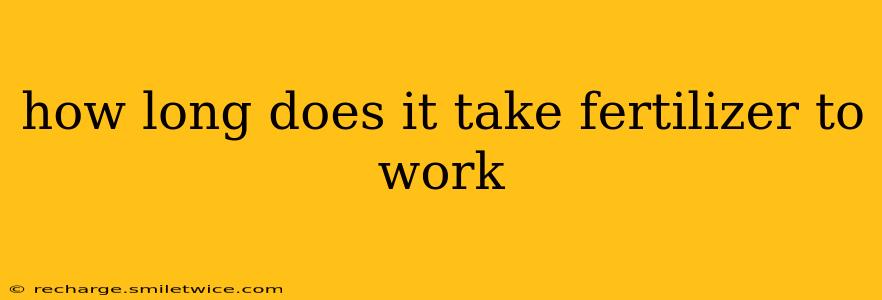How Long Does It Take Fertilizer to Work? A Comprehensive Guide
The question, "How long does it take fertilizer to work?" doesn't have a simple answer. The timeframe depends on several crucial factors, making it more complex than a quick numerical response. Let's break down the variables and provide a comprehensive understanding.
What Type of Fertilizer Are You Using?
Different fertilizers release nutrients at varying speeds. This is a key factor determining how quickly you'll see results.
-
Fast-Release Fertilizers: These are often water-soluble and provide a quick boost of nutrients. You'll likely see visible results within a week or two, particularly with leafy green growth. However, this effect is often short-lived, requiring more frequent applications.
-
Slow-Release Fertilizers: These release nutrients gradually over several weeks or months. While the initial impact might be slower, the effects are longer-lasting, reducing the need for frequent fertilizing. This is often preferred for long-term plant health.
-
Organic Fertilizers: Compost, manure, and other organic materials release nutrients very slowly through decomposition. You might not see immediate results, but the benefits extend over a longer period, improving soil structure and fertility in the long run. This often takes several months to show significant effects.
What Are You Fertilizing?
The type of plant also greatly impacts the timeframe.
-
Fast-Growing Plants: Vegetables, annual flowers, and some herbs respond more quickly to fertilizer due to their rapid growth cycles. You might see results within a week or two with fast-release fertilizers.
-
Slow-Growing Plants: Trees, shrubs, and perennials may take several weeks or even months to show visible effects from fertilization, even with fast-release options. Their slower metabolism means they absorb nutrients at a slower rate.
What Are the Soil Conditions?
Soil type plays a significant role.
-
Well-Drained Soil: Nutrients are readily available in well-drained soil, leading to faster uptake by plants.
-
Poorly Drained Soil: Waterlogged soil hinders nutrient availability, delaying the effects of fertilization.
-
Soil pH: The acidity or alkalinity of your soil impacts nutrient availability. An unsuitable pH can lock nutrients, preventing their uptake by plants, regardless of the fertilizer type. Soil testing is crucial to ensure optimal pH levels.
How Much Fertilizer Did You Apply?
Over-fertilizing can be harmful, causing "fertilizer burn" that damages plants. Under-fertilizing will also result in slower growth and less visible results. Following the instructions on the fertilizer packaging is paramount.
Environmental Factors
Weather conditions, particularly temperature and rainfall, influence nutrient uptake. Warm temperatures and adequate moisture generally speed up the process.
What are the signs that fertilizer is working?
You'll notice improved plant health in various ways:
- Increased growth rate: Taller stems, more leaves, and faster flowering or fruiting are all positive signs.
- Deeper green color: Healthy plants have a vibrant, deep green color.
- Increased flower and fruit production: Fertilizer provides the nutrients necessary for abundant blooms and larger, more plentiful fruits.
- Stronger stems and leaves: Plants should be more resistant to disease and pests.
In summary, there's no single answer to how long fertilizer takes to work. It's a complex interplay of factors, requiring careful consideration of fertilizer type, plant species, soil conditions, application rate, and environmental conditions. Patience is often key, and monitoring your plants closely will reveal the effects of your fertilizing efforts.
